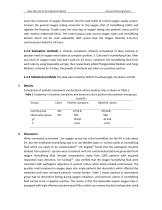
Catalog excerpts

Journal of Nursing Science Application and effects of disposable aseptic three-way-stopcock oxygen tube LIU Yumei, JIANG Weirong, XU Miao Abstract: Objective To observe clinical application effect of disposable aseptic three-way-stopcock oxygen tubes. Methods A total of 210 patients were divided into two groups. One of which used normal oxygen tubes, and the other used aseptic three-way-stopcock oxygen tubes, with the flowrate 2-5L/min for 24 hours. Results Comparing the patients complaints and the bacterial culture positive rates between two groups, the differences had statistical significance (p<0.01). Conclusion The disposable aseptic oxygen inhalation devices can obviously decrease the patients’ discomforts and bacterial infection rates, which make the oxygen inhalation safer. Keys words: Oxygen inhalation; Disposable oxygen tube; Disposable aseptic oxygen tube; Comfort; Bacterial culture; Infection; Nursing CLC NO: R472 WM:B Article ID:1001-4152(2012)09-0023-01 DOI:10.3870/hlxzz.2012.09.023 At present, most hospitals use centralized oxygen supply, the supply pipes are sealed, no way to clean and disinfect which can easily produce bacterial and peculiar smell. Our department used the disposable aseptic oxygen tubes instead of normal oxygen tubes, observed the effects and then came to the results. 1 Objects & Methods 1.1 Objects Selected a total of 210 patients who stayed in hospital between September 2010 and May 2011, including 108 males and 102 females, aged between 17~65 years old with the average of 47 years old. All of them suffered from acute upper gastrointestinal diseases, but had conscious and had no nasal symptoms, heart-lung diseases or renal insufficiency. These patients were randomly divided into the observation group (105 cases) and control group (105 cases). Compared the general data of the two groups, the differences had no statistical significance(p>0.05). 1.2 Methods 1.2.1 Oxygen inhalation methods The observation group used the disposable aseptic oxygen inhalation devices which are composed with oxygen tubes, three-way-stopcocks and humidifying devices (with sterile humidifying fluid) made by Wuhan W.E.O Science &Technology Development Co., Ltd. The oxygen tube is composed with general connector, tubing, sterilizing filter, nose tips; The humidifying device is composed with humidifying bottle, sterile humidifying fluid, foam generator and anti-bacterial filtration membrane. Firstly connect the thread interface on the bottom of oxygen flowmeter with the thread interface of three way switch, insert the port of oxygen inlet of humidifying bottle into the bottom connector of three way switch. Then
Open the catalog to page 1
Journal of Nursing Science insert the connector of oxygen flowmeter into the wall outlet of central oxygen supply system. Connect the general oxygen tubing connector to the oxygen inlet of humidifying bottle and regulate the flowrate. Finally insert the nose tips of oxygen tubing into patients’ noses and fix with medical rubberized fabric. The control group used normal oxygen tubes and humidifying devices which can be used repeatedly. Both group kept the oxygen flowrate 2-5L/min, continuously inhaled for 24 hours. 1.2.2 Evaluation methods 1. Patients complaints. Patients complained of...
Open the catalog to page 2
Journal of Nursing Science 98% bacterial or gas pathogens[4] from oxygen, the bacterial generated from humidifying fluid. It can also prevent cross contamination between patients and humidifying devices, thus make oxygen therapy safer and more comfortable. Reference [1] TONG Jianhua, research in germiculture grew in humidifying fluid[J]. Chinese Journal of Nosocomiology, 2006,16(7):741. [2] HE Jingling, analyze pathogens from 1000 patients with respiratory tract infections[J]. Journal of Postgraduates of Medicine, 2005,28(2):45-46. [3] XU Yunfang,ZHOU Limei,XU Runxia etc. Integrated...
Open the catalog to page 3All Wuhan W.E.O Science & Technology Development catalogs and technical brochures
-
Suction Catheter
1 Pages
-
PN-V03
1 Pages
-
NS
1 Pages
-
WEO-BYG-1/2/3
1 Pages
-
WEO-EN-LP-01/02
1 Pages
-
Infusion accessories
2 Pages

















